Prototypes & Specials
Contents
(Scroll down or click on Links)
Prototypes
There is not much information about Yashima/Yashica prototypes. The earliest sighting is a pair of 1954 ads featuring the Yashica Flex model S, one including a photo and the other a line drawing of the same camera.
(Right detail from larger web image)
(Click on left image for larger view of camera)
Rather than the model we are familiar with, the camera looks more like a Pigeonflex with meter. It's probably a version that Yashima would not have publicised but its partner for this model, Seiko, used the ads to promote its Baby Sekonic exposure meter.
The next appearance is probably the Yashica Hi-Mec model S. Although nothing is known about the origins of this model, it is likely to be pre-production version of the 1956 Yashica LM. Two have been for sale, possibly as a result of extensive pre-release marketing activity with US dealers (documented).
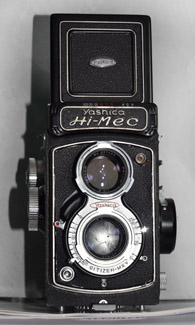 (Image courtesy of Jean-Marie Bussiere)
(Image courtesy of Jean-Marie Bussiere)
Then there is the Yashica Auto 44 from 1959. Sugiyama doesn't consider it to be rare but apart from the one photo in his book and a possible eBay sale in 2003, there have been no other known sightings in Japan or elsewhere. I am inclined to think that it was a prototype for the Yashica 44LM (whilst the body looks similar, it is most definitely not simply a re-badge as has been suggested by some - there is crank-wind and a suggestion of f/2.8 lenses for a start).
The following two are developmental prototypes focusing on new technology. The Yashica Future 127 is well documented, the Yashica Beacon is a mystery but appears to originate from Yashica itself.
Yashica Future 127 - Automatic Exposure
The Yashica Future 127 is the technological ancestor of the Yashica E released in 1964, the only automatic exposure Yashica TLR. Camera-wiki.org has details and photos of the prototype which was developed in partnership with Konan Camera Laboratory in response to US and German models with automatic exposure facility and officially revealed in March 1959. The Future 127 was the first Japanese model with that ability. With the popularity of the 127 format fast starting to wane, the camera never made it to production, however, the technology carried over to the 35 mm format with the 1961 Flash-O-Set and subsequent models.
Whilst the 35 mm models continued to evolve, the functionality of the Yashica E was almost the same as the 1961 Flash-O-Set with its inbuilt bulb flashgun and single speed 1/60 shutter. The Flash-O-Set was released with the selenium cell above the lens but the updated Flash-O-Set II model moved it to around the lens as in the later Yashica E.
The Future 127 was not a TLR but in common with TLR models, the format was 4 cm x 4 cm and the film traveled vertically. Unlike the single speed Flash-O-Set and Yashica E, the Future 127 had a proper Copal shutter (MXV according to documents and SV according to photographs) but the speeds corresponded to ASA settings! So, effectively, there was still only one speed per ASA setting available - if you wanted to use 1/500, then you were limited to 200 ASA film and vice versa. The auto aperture setting was driven by electricity generated by the selenium cell.
Yashica Beacon - Focus Assist
Details and more photographs can be found on Barry Toogood's website www.TLR-Cameras.com. Almost nothing is known about this camera. According to Barry, it turned up on eBay in 2005:
![]()
It seems to be based on a Yashica-Mat body, perhaps a Yashica Mat-LM as it has that model's unique DIN/ASA conversion table on the crank housing cover. It has the later wide “Y” hood logo which didn't appear until 1965 (i.e., after the Yashica Mat-LM ceased production) but for a prototype, these details are irrelevant apart from suggesting mid-1960s.
The nameplate or exposure meter housing, depending on donor body, has been replaced by quite a sophisticated pressing (closer to production ready than a cobbled together first attempt) in a shape and size similar to the Yashica Mat-LM and EM exposure meter housings. The “Yashica” name on top and “Beacon” on the front appear to be professionally done in a way that you would expect from the factory. There are two circular windows, one at either end of the housing, emitting light beams forward. There must be some physical connection to the focusing system - there seems to something attached to the top of the lens board (see Focuspot for Rolleiflex below). As the in-focus point is approached the beams come together to coincide at the exact point of focus. It is basically a rangefinder using projected light and therefore you can use it as a focusing assist when using either the reflex viewfinder or straight through eye level sports finder simply for framing. Clearly something that would be useful in low light situations, providing that being discreet wasn't an issue. The batteries are contained in a large and probably inconvenient rectangular box attached to the camera's back.
The photos from Barry Toogood's website also appear on the Novacon website. Additionally, this site displays a “Kalart Focuspot” accessory that seems to work in the same way and mounts to the bottom of Rolleiflex TLRs. It is claimed to be from 1947:
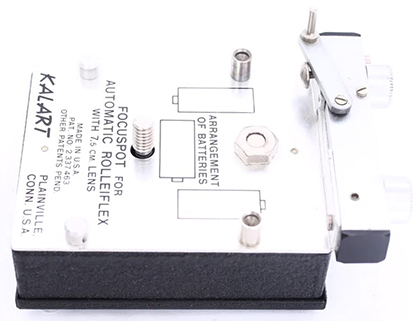
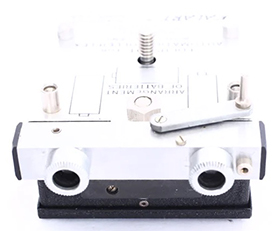
(Web images from a different site)
Note the spring loaded pivoting lever and post at the front. This transfers the in/out focusing movement of the lens board to the “rangefinder”.
A Focuspot attachment for the “Kalart Synchronized Rangefinder” for press cameras is displayed as well. Correspondent Lou Zurn has directed me to Jo Lommen's Graflex website which also led me elsewhere and the discovery that US made Kalart rangefinders were a very popular accessory for press cameras generally, not just Graflex models. However, from 1939, Graflex Pacemaker Speed Graphics were fitted with side-mounted Kalart rangefinders as standard. Kalart offered the Focuspot attachment as a low light focusing aid, turning the rangefinder into a projector but otherwise still operating the same way. It could be left permanently attached. The 1955 Pacemaker Crown and Speed Graphic were fitted with a top-mounted “Graphic Rangefinder” with built-in “Rangelite”. Clearly, the use of the projected light beams for low light focusing was a well proven concept, just not in the TLR sphere - the Kalart Rolleiflex accessory is very rare so definitely not an in-demand item.
So what was Yashica's thinking? It was a company that offered good quality at low prices and sold on volume to make a profit. It rarely raised its head above the trenches to appeal to more niche market segments, or to take risks. Presumably the Beacon contained a rangefinder too to control the beams, the whole set-up wouldn't have been cheap to produce and there was that battery pack on the back as well.
Specials
These are not Yashica's handiwork but do represent interesting adaptations for particular purposes.
Yashica Stereo Camera for 3D Photography
This is an unusual camera for taking stereo photographs (two offset but otherwise identical images) for the purpose of 3D imagery. It is functional without much consideration for aesthetics or fine finishes and is clearly not something that Yashica would have produced. It was offered for auction twice in Sweden, first in December 2010 and then selling in April 2011 to an Australian dealer. He then sold it to its current owners in Canada, Sandu & Alina Baciu, who contacted me with the details.
According to the auction description:
Black paint, 2x 6x6cm, with Yashinon 3.5/80mm in Copal-SV 1-1/500sec, Porroflex viewfinder and double cable release. Provenance: Reportedly custom made by Walt Disney engineers.
The camera focusing hood has a late Yashica Mat-124G serial number which puts it at around 1984 to 1985 - obviously it could have been assembled any time after that.
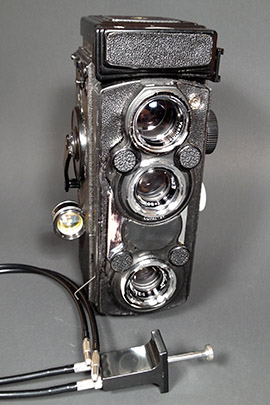
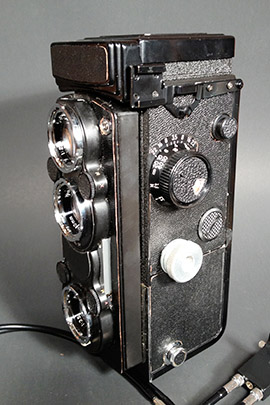
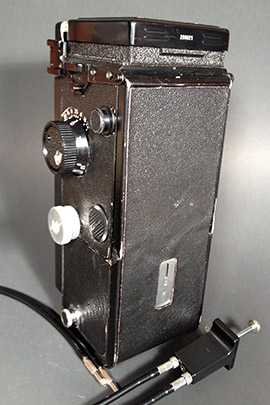
(Images provided courtesy of Sandu Baciu)
The design puts the taking lens half of a Yashica Mat-124G focusing panel with lens assembly on the bottom of another complete 124G with the control wheels of each taking lens linked to ensure identical exposures. However the bottom half of the actual body appears to be Yashica A. The two backs have been joined into one long back with the Yashica A red window on the bottom. The crank advances the film but I'm not sure about the technicalities of correct frame spacing. The exposure meter CdS cell has been removed and blanked off.
Stereo photographs would normally be taken with the camera horizontal to match human vision and therefore a protruding tripod socket has been installed on the focusing side and a viewfinder on the crank side. The normal TLR viewfinder remains functional but it also came with a modified Mamiya Porroflex (mirror type) so presumably the camera would be used upright as well, perhaps for photographing artwork which could be turned on its side for convenience.
Why? Franke & Heidecke got into the business of making stereo cameras before releasing the Rolleiflex. First there was the Heidoscop and then the Rolleidoscop, a 120 roll film version. Production ceased at the start of WW II. Some people believe that medium format 3D slides produced resolution even unachievable today with digital technology. I wont argue with that one but in the 1980 to 1990 period, a 120 3D camera was probably by far the best solution available. Why didn't Walt Disney simply save up and buy a used Rollei? (There could be many answers; before on-line auctions sourcing rare cameras may not have been fast or easy, didn't meet their design needs, Walt Disney had heard that Yashica was better ...)
Yashicaflex 6x4.5
Sandu Baciu also sent me details of the following camera. To me it looks like a Yashica A with Yashicaflex C nameplate and the serial numbers on the lenses and nameplate seem to confirm this. Yet this camera is more. Someone has fitted a second red window to the back. This seems designed to read the edge numbers on 120 film for the 6x4.5 format which the Yashica Rookie seems to do rather more elegantly. Note there is no cover for the window nor mounting posts on the hood for a 6x4.5 format insert for the sports finder, both items that Yashica would have surely included if it had come out of the factory, even as a one off. However, it obviously met someone's needs.
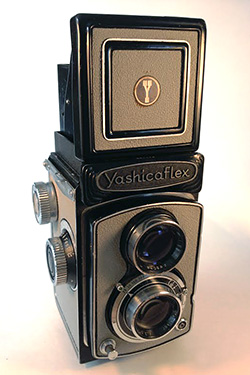
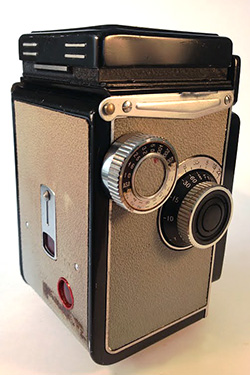
(Images courtesy of Sandu Baciu)

